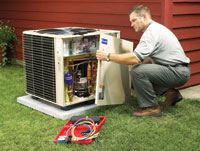With the transition to 13 SEER, there is an increased focus on making sure the more costly, higher efficiency systems are installed properly. It is well known that the larger sizes of both the indoor and outdoor coils could possibly be a challenge in new installations and retrofits. Given the potentially more labor-intensive nature of a 13 SEER installation, some contractors may overlook the other important aspects of a quality installation.
The best advice for those installing 13 SEER equipment is to review the basics. Consult ACCA's Manual J to make sure the system is sized correctly. Make sure the ductwork doesn't leak and is sized properly. Check (and double-check) the proper amount of refrigerant for the system, so it won't be over- or undercharged.
Basically, the same rules apply to 13 SEER as they did to 10 SEER: Follow all the manufacturer's guidelines, and install the system as you would in your own home.

FOCUS ON DUCTWORK
According to the Department of Energy, typical duct systems lose 25 percent to 40 percent of the cooling energy put out by a central heat pump or air conditioner. One of the reasons behind this problem is that contractors do not spend enough time sizing the duct system for a house."Homeowners are being sold a 13 SEER system, and if it's not installed with the proper ductwork, they may only get 8 or 10 SEER in energy efficiency," said Tim Fletcher, brand manager for air conditioning contractors and end users, Emerson Climate Technologies, Copeland, Sidney, Ohio. "We're also concerned with ductwork issues because, if there's not enough airflow, it could cause long-term reliability issues for the compressor."
Francis Franck, VP Sales, Texas Furnace, Houston, noted that duct sizing will be a bigger issue with higher efficiency systems because many manufacturers are meeting the 13 SEER mandate by putting greater fin density into their coils. "Traditionally, we have never placed more than 11 fins per inch in a four-row coil. Now we see ARI data that shows some manufacturers are using up to 18 fins per inch on four-row coils. Without considerable allowances being made for the coil density, these systems may have serious airflow problems."
Franck added that evaporators with more air resistance will require more blower wattage to make the system work. "The blower wattage goes up, and the installed SEER comes down. In addition, some manufacturers are reducing the cfm per ton cooling ratio to a figure considerably less than 400 cfm per ton. This is going to create interesting systems, because they may work well in the lab, but when they encounter the average duct system, my bet is they won't make 13 SEER. And homeowners may not be comfortable either."
The good news is that in applications with restrictive ductwork, if the installed high-efficiency system uses a variable-speed motor for the indoor blower, it will still deliver (or at least try to deliver), the required airflow rate. However, it will do this at the cost of additional electrical power consumption, which will ultimately hurt system efficiency.

CHARGING AND SIZING
As with any air conditioning system, be it lower or higher efficiency, over- or undercharging the system can affect operating cost, system capacity, humidity removal, system operating life, and home comfort. Franck noted that he looks at 13 SEER systems as he would a higher performance automobile. "The higher the performance, the more critical that it be correctly tuned. A lot of the ‘tuning' on a 13 SEER system is accomplished through proper charging."Typically, there is more charge in a high-efficiency system because the outdoor unit is bigger. Therefore, the degradation in system performance per unit mass of overcharge or undercharge is less significant on a high-efficiency system relative to a lower efficiency system. However it could also be argued that it's just as easy to improperly charge a high-efficiency system, because there is a smaller change in system subcooling per unit mass of charge added or removed from the system.
The increased usage of thermal expansion valves in high-efficiency systems should result in better performance and reliability if the system is over- or undercharged, but the bottom line is to place the correct charge in all units. Properly charging a unit does not mean placing your hands on the line and waiting until it's cold, or relying on other rules of thumb.
According to Fletcher, "Contractors who have installed 10 SEER equipment from a particular manufacturer for a number of years may have the charge table in their heads. With the new equipment, contractors need to take the time to review their charging practices and the application guidelines of the systems they are installing."

If a 13 SEER system is installed incorrectly, there is almost no limit to the amount of efficiency that could be lost. In fact, it's entirely conceivable that a 13 SEER system could become a 6 SEER system if not installed properly. To make sure customers get the efficiency they're paying for, Franck suggests that contractors exert some extra effort in order to brush up on their installation skills.
"Learn how to properly charge a system," Franck said. "Understand thermal expansion valves and how they operate. Spend some personal time learning about superheat and subcooling and how they relate to and affect system performance. Spend the time, effort, and money to get the necessary schooling to be able to properly install and tune a system for peak performance."
Good advice for anyone who will be installing 13 SEER systems.
Publication date: 02/27/2006




